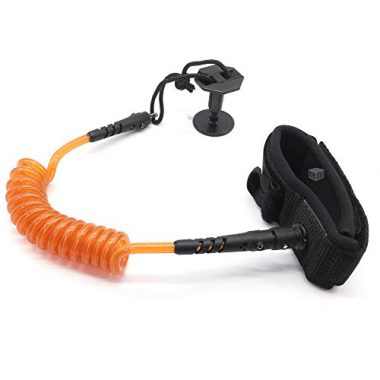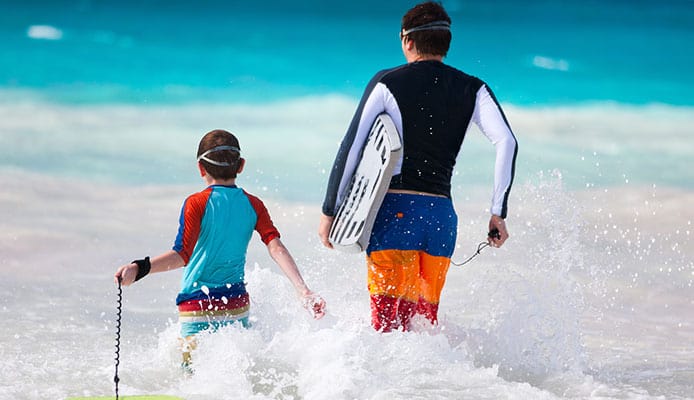
Every bodyboarder knows that getting wiped out by a wave is something that happens occasionally. The main problem here is if your board gets carried away from you. Instead of swimming to get it or chasing it to the shore, wearing a bodyboarding leash will always keep your bodyboard within reach.
Whether you wear them on your wrist or bicep, the best bodyboard leashes won’t break even on strong impacts, significantly improving your safety on the open water. When shopping for a new bodyboarding leash, make sure to consider plug quality, coil length, as well as cuff comfort and adjustability.
To help you with this, we’ve created a buying guide that breaks down these features and explains what works best on the water. But before we dive in, check out the awesome bodyboard leashes we picked out for you.
OUR TOP PICK
BPS Storm Coiled Pro Bodyboard Leash
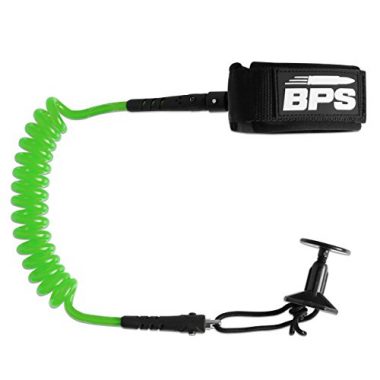
- Stand Out Features - Why We Love It
- Comfortable wrist cuff with Velcro closure
- Dual stainless steel swivels prevent tangling
- Tight coil prevents leash drag
- Package includes a leash plug
- Seven color options available
Position: Wrist
Length (extended): 4 feet
Cord material: Thermoplastic polyurethane (TPU)
Cord thickness: 7.2 millimeters
Cuff material: Neoprene
Weight: 7.2 ounces
EDITORS CHOICE
Own The Wave Nemesis Bodyboard Leash
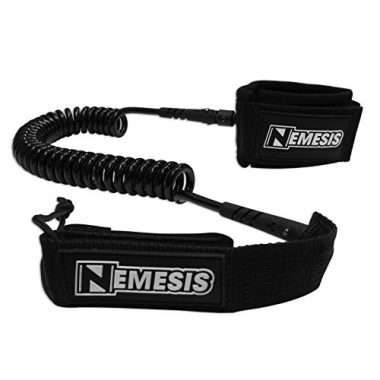
- Stand Out Features - Why We Love It
- Extra-strong 10-foot cord
- Padded neoprene cuff with a hidden key pocket
- Quick-release tab for fast leash detachment
- Stainless steel swivels and precision-molded fittings
- Backed with a 1-year guarantee
Position: Wrist/Bicep
Length (extended): 10 feet
Cord material: TPU
Cord thickness: 7.2 millimeters
Cuff material: Neoprene
Weight: 9.1 ounces
BEST VALUE
Tagvo 4 Feet Bodyboard Leash
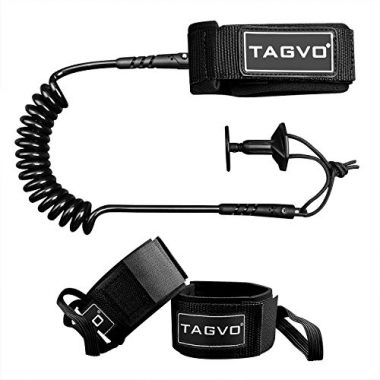
- Stand Out Features - Why We Love It
- Reinforced cuff with Velcro closure and a key pocket
- Thick coils prevent snagging on objects
- Cuff has fin tethers (if used on the ankle)
- Dual-swivel system prevents cord tangling
- Fits wrists and biceps from 10 to 14 inches (circumference)
Position: Wrist/Bicep
Length (extended): 4 feet
Cord material: Polyurethane
Cord thickness: 7 millimeters
Cuff material: Padded neoprene
Weight: 6.4 ounces
Creatures of Leisure Ryan Hardy Bodyboard Leash
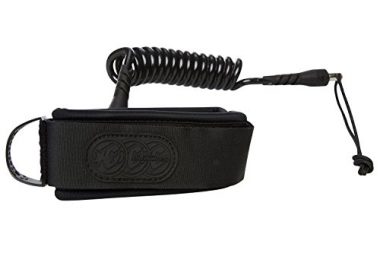
- Stand Out Features - Why We Love It
- DNA Flex mould for ultimate comfort
- Heat-bonded urethane improved cord durability
- 360-degree rotator swivel system eliminates tangling
- Neo-mesh cuff doesn’t slip on your arm
- Surefire urethane tag for fast leash release
Position: Wrist/Bicep
Cord material: Polyurethane
Cord thickness: 7 millimeters
Cuff material: Neo-mesh
Weight: 6.4 ounces
How To Choose A Bodyboard Leash – Buying Guide
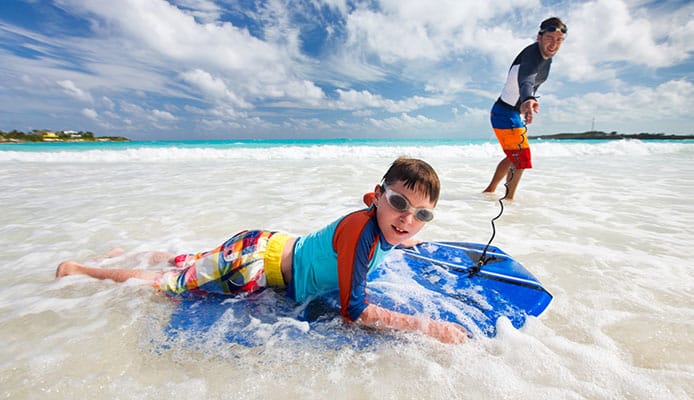 top five are the very best that the boarding wold has to offer (in our opinion). With the information above, you can make an informed choice when it comes to enhancing your bodyboarding experience. Be safe out there.” width=”694″ height=”400″ />
top five are the very best that the boarding wold has to offer (in our opinion). With the information above, you can make an informed choice when it comes to enhancing your bodyboarding experience. Be safe out there.” width=”694″ height=”400″ />
Leash position (Bicep or Wrist)
Depending on the model, bodyboard leashes are either worn on the wrist or on the bicep. Some models can be used in both positions, adding versatility in different riding situations. Which one you should choose (bodyboard leash bicep or wrist position) depends on your previous bodyboarding experience as well as your technique and style.
Wrist leashes are excellent for beginner riders or if you enjoy drop-knee bodyboarding. For beginners, the draw is the ease of getting your board back. When you do come off your board, it is easy to grab the cord and bring your board back to you.
For drop-knee bodyboarders, a bodyboard wrist leash makes sense because you are sitting higher on your board (on one knee). Having the leash on your bicep creates too much distance between the cuff and the board, resulting in uncomfortable tension. The downside of wrist leashes is that the coil gets in your way while paddling.
Bicep leashes are a better choice for experienced bodyboarders who don’t have trouble getting back on the board. Having the leash on your bicep prevents the coil from getting in your way when you are paddling through the water. This gives you more freedom and makes you faster and more efficient.
Plugs
Leash plugs attach the leash to your board. To make sure it doesn’t break, you want something made from high-quality plastic. The plug parts fasten together and give a secure hold on the board. The plug ends should be flat so that they sit flush with your board (you’ll be annoyed if they are sticking out).
Additionally, you should also look for plugs that have the means to attach the string internally (instead of having loops around your board). The more seamless of a fit you can get, the better.
String
The string should be short, just long enough to join the plug and coils together. There should be enough room for a little movement when you and the board move. The function of the string is to join those two elements together with some flexibility. When looking at the string, it should be strong and tough. It will be pulled on a lot as you move through the water and you don’t want it to snap while you’re in the water. The tie on the string should be tight so that it does not slacken and come loose.
You might also like: Perfect Bodyboard Fins
Cuffs
The cuff should be comfortable to wear – this is probably the most important function of the cuff. Granted, it should stay on your arm and keep you teetered to the board, but a good leash is pleasant to wear. The best cuffs are generally made from neoprene and have a Velcro strap for adjusting. Both neoprene and Velcro should be durable and not begin to break down after a few uses. Look for a wide cuff to add comfort when you are wearing it.
On top of this, you should also look for a cuff with a brass connector. The cuff is jointed to the coil, and there should be a connector that allows a wide range of movement. Brass is ideal for this and guarantees a long-lasting bodyboard leash.
Coils
The coil will be your buffer between the cuff and the plug. It should be long enough to give you some room on the board, but short enough that when you do fall off the board, the board does not get too far. The coil should be springy so that it can lengthen and shorten depending on the situation. Look for a coil made from polyurethane or similar high-quality material.
FAQs
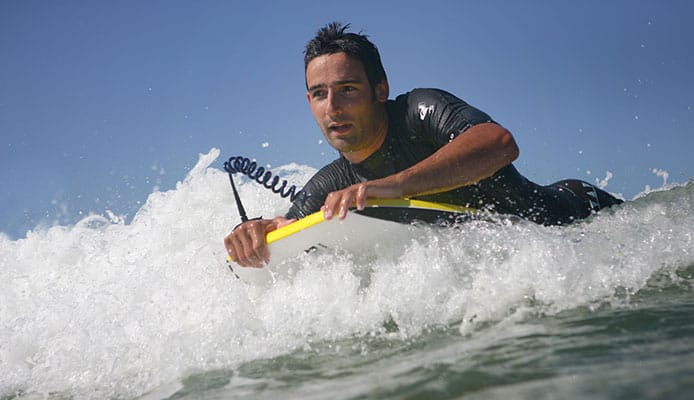
Q: Should I Use A Bodyboard Bicep Leash Or A Wrist Leash?
This comes down to your preference – there really is no right or wrong answer when it comes to picking. Both bodyboard bicep leashes and wrist leashes have some pros and cons, so it’s best to choose based on your riding style and experience. As we’ve mentioned earlier, wrist leashes make it easier to retrieve the board, while bicep leashes are easier to paddle with.
Q: How Should A Bodyboard Leash Fit?
A bodyboard leash should fit comfortably. Most come with a velcro strap, so they are easy to adjust. The cuff should be tight enough that it does not move and slip down your arm, but it shouldn’t bite into your skin either. When your arm is relaxed, the leash should not be digging into your skin.
Q: How Do You Put On A Bicep Or Wrist Leash?
The first thing you need to do is choose whether you are going to put the leash on your wrist or on your bicep. If you’re putting it on the wrist, place it just above the joint and tighten it just so it can’t slip over your hand.
If you want to put it on the bicep, slide it above the elbow, bend your arm and tighten it. It shouldn’t press too hard when you’re paddling or moving your hand.
Q: Where Do You Put A Leash On A Bodyboard?
There is no rule that defines the exact position. This being said, riders usually place the leash plug for the boogie board strap 6-8 inches down from the nose, slightly moved to the hand side on which they want to wear the leash. You can also install it in the center if you plan to switch hands.
Q: How Do You Install Bodyboard Leash Plug?
Installing a bodyboard leash plug is a relatively simple operation. The only tools you need are a pencil, a screwdriver, and a lighter.
- Choose the hole position (6-8 inches from the nose, avoid going through or close to stringers)
- Mark the future leash plug bodyboard position with your pencil
- Place the screwdriver at a 90-degree angle over the board so it won’t go sideways
- Carefully push the screwdriver through the board until you reach the plastic deck
- Take the screwdriver out, warm it up, and push it in again – this time through the bottom plastic
- Insert top part of the leash (one with the coil)
- Insert the bottom part (screw) and carefully tighten it with a screwdriver or a coin
Globo Surf Overview
If you allow your bodyboard to escape in the ocean, you might as well be throwing away your money into the water. A good bodyboard leash will prevent this and always keep you close to your board. Even if your board doesn’t get away from you, retrieving it after getting wiped out is infinitely easier with a leash attached.
It doesn’t matter if you are buying one for safety or to make your life easier, it just makes sense to have one with you at all times. Our top five are the very best that the boarding wold has to offer (in our opinion). With the information above, you can make an informed choice and enhance your bodyboarding experience.


